INTRODUCTION
Over-the-scope clips (OTSCs) provide a new means of treating gastrointestinal (GI) bleeding and closure of perforations and fistulas. OTSCs from Ovesco (Tübingen, Germany) have been successfully used for both closing GI defects [
1] and in cases of refractory GI bleeding [
2]. OTSC-assisted effective full-thickness resection (EFTR) for removal of mucosal and sub-mucosal GI lesions has also been shown to achieve good results in terms of efficacy and safety [
3].
The Padlock clip (Aponos Medical Co., Kingston, NH, USA) is a more recently introduced device in the category of OTSCs. It requires the use of an alternate technique and has a design that differs from the Ovesco variety of OTSCs. However, data regarding its clinical use are currently limited [
4]. The aim of this study is to present our clinical experience using this novel Padlock clip system.
Go to :

RESULTS
A summary of the patients’ demographic data, diagnosis, follow-up and adverse events is provided in
Table 1. In our study, we used the standard model mounted onto the tip of the gastroscope (Olympus GIF-HQ190, diameter of 9.9 mm, working channel of 2.8 mm; Olympus, Tokyo, Japan). The Padlock clip was applied after invagination of the tissue inside the cap by suction, which also allowed for continuous removal of blood and secretions. Subsequently, after sufficient target tissue could be suctioned into the cap, the clip was deployed creating a pseudo polyp of the target lesion above the closed clip. We did not require any additional auxiliary forceps for tissue invagination.
Table 1.
Summary of Patient Characteristics
|
Case No. |
Age |
Sex |
Diagnosis |
Previous therapeutic attempt |
Primary success |
Follow-up at 1 and 3 wk |
Last follow-up (days) |
Adverse events |
|
1 |
56 |
F |
Angiodysplasia in body of stomach |
APC |
Yes |
No rebleeding |
84 |
None |
|
2 |
69 |
M |
Large D1 ulcer (2.5 cm) Forrest class Ib |
None |
Yes |
No rebleeding |
75 |
None |
|
3 |
72 |
M |
Bleeding gastric ulcer Forrest class Ib |
None |
Yes |
No rebleeding |
70 |
None |
|
4 |
49 |
M |
Gastric NET |
None |
Yes |
No recurrence |
61 |
None |
|
5 |
64 |
M |
Rectal polyp (Tubular adenoma with moderate dysplasia) |
None |
Yes |
No recurrence |
52 |
None |
|
6 |
45 |
M |
Duodenal NET |
None |
Yes |
No recurrence |
39 |
None |
|
7 |
37 |
M |
Large D1 ulcer (2 cm) Forrest class Iia |
None |
Yes |
No rebleeding |
21 |
None |

We used 7 Padlock clips for 4 patient presenting GI bleeding, as well as for 2 patients with NET and 1 patient with rectal polyp. The first patient had 2 different sites of hemorrhage: one site located in the body of the stomach (
Fig. 2A) and another located in the first part of duodenum. Hemostasis was not achieved for the stomach lesion after initial use of argon plasma coagulation and drainage was noted on relook endoscopy. This drainage was controlled by application of a Padlock clip at the site of angiodysplasia (
Fig. 2B).
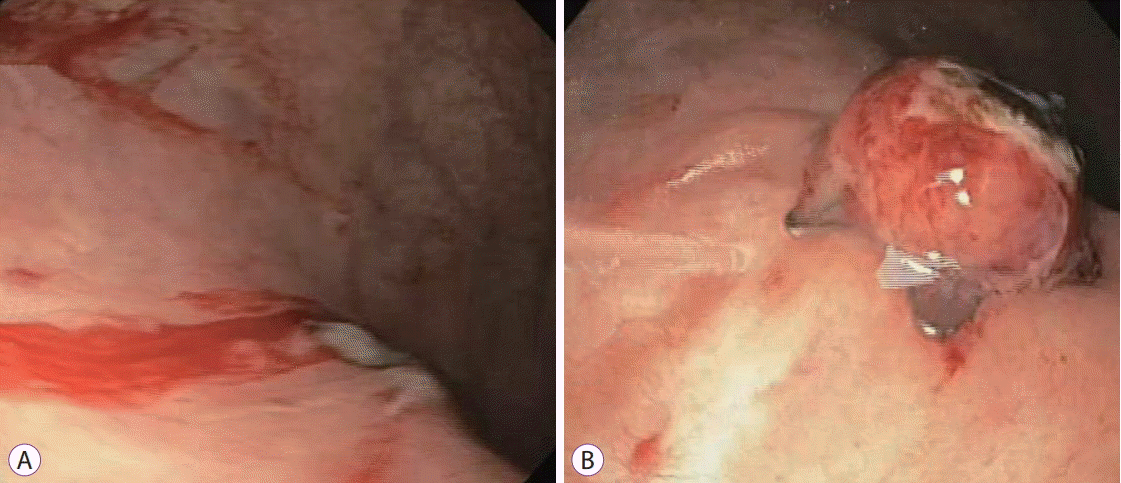 | Fig. 2.(A) Angiodysplasia in stomach with discharge. (B) Padlock clip (Aponos Medical Co., Kingston, NH, USA) applied near bleeding point. 
|
The other 2 patients had a duodenal ulcer (Forrest class Ib;
Fig. 3A) and gastric ulcer (Forrest class Ib;
Fig. 4A), respectively, for which no previous therapeutic intervention had been attempted. Both patients were on dual anticoagulant therapy in the setting of coronary stents, and mechanical options, rather than thermal options, were preferred. The Padlock clip was successfully deployed in both patients (
Figs. 3B,
4B) and hemostasis was achieved. Anticoagulation therapy was reinstated within 48 hours of the endoscopy procedure. The fourth and sixth patients were diagnosed with NETs (
Figs. 5A,
6A), while the fifth patient had a sessile rectal polyp (
Fig. 7A), with histopathology suggestive of tubular adenoma and moderate dysplasia. The rectal polyp measured 2×2 cm, and the diameter of the gastric and duodenal NET was about 1 cm. A Padlock clip was applied for EFTR of the lesions in these 3 patients (
Figs. 5B,
6B,
7B). The lesion was subsequently resected en bloc above the clip using polypectomy snare forceps (
Fig. 7B). R0 resection (margins negative for malignancy) was achieved after EFTR of the polyps. There was no noted recurrence of the lesion in the follow-up period at 1 and 3 weeks postoperatively. The seventh patient who presented with hematemesis also had a large ulcer (2 cm) in the first portion of the duodenum and was managed successfully with Padlock clip application. All 7 patients were hospitalized post procedure for a minimum of 48 hours and were monitored closely for any adverse events.
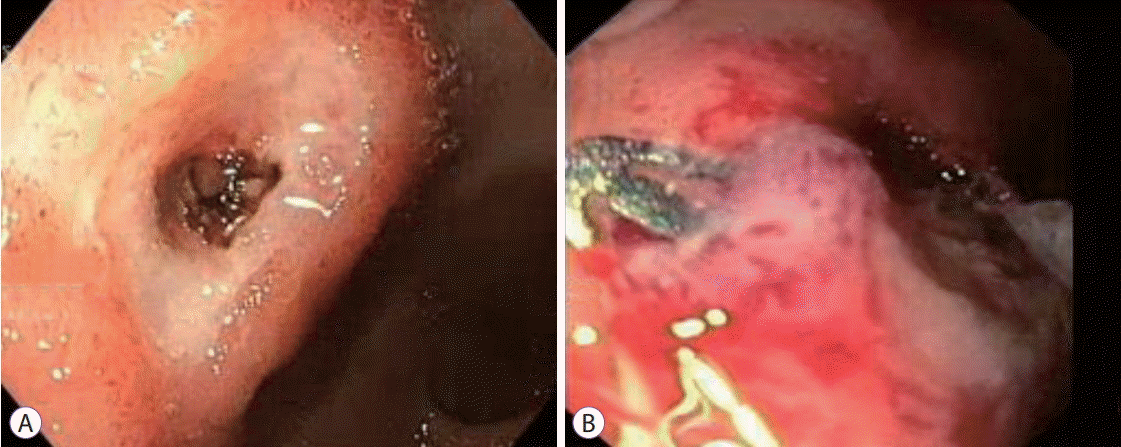 | Fig. 3.(A) Large duodenal ulcer observed at first part of duodenum. (B) Padlock clip (Aponos Medical Co., Kingston, NH, USA) applied at the ulcer site. 
|
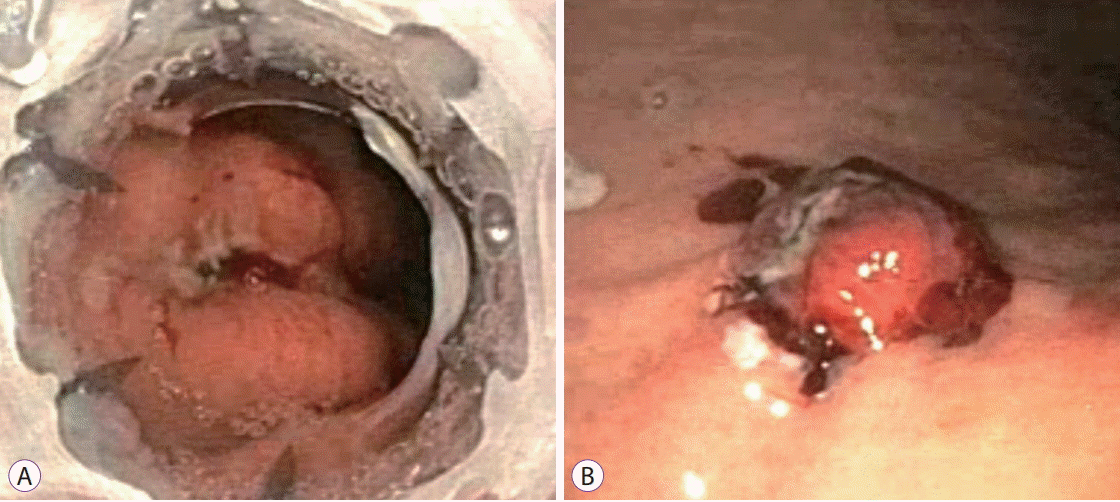 | Fig. 4.(A) Discharge from the gastric ulcer. (B) Padlock clip (Aponos Medical Co., Kingston, NH, USA) applied and hemostasis achieved. 
|
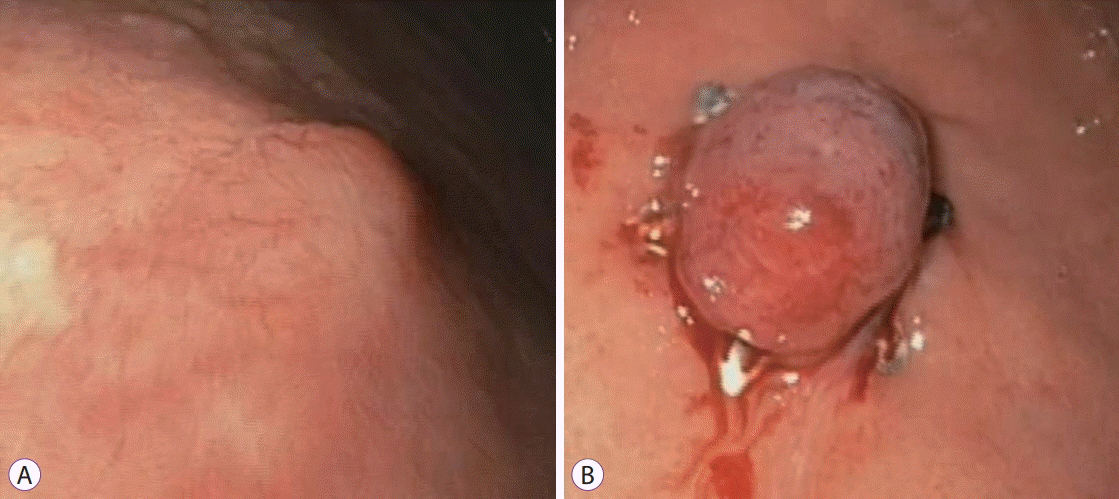 | Fig. 5.(A) Gastric neuroendocrine tumor. (B) Padlock clip (Aponos Medical Co., Kingston, NH, USA) surrounding the nodule. 
|
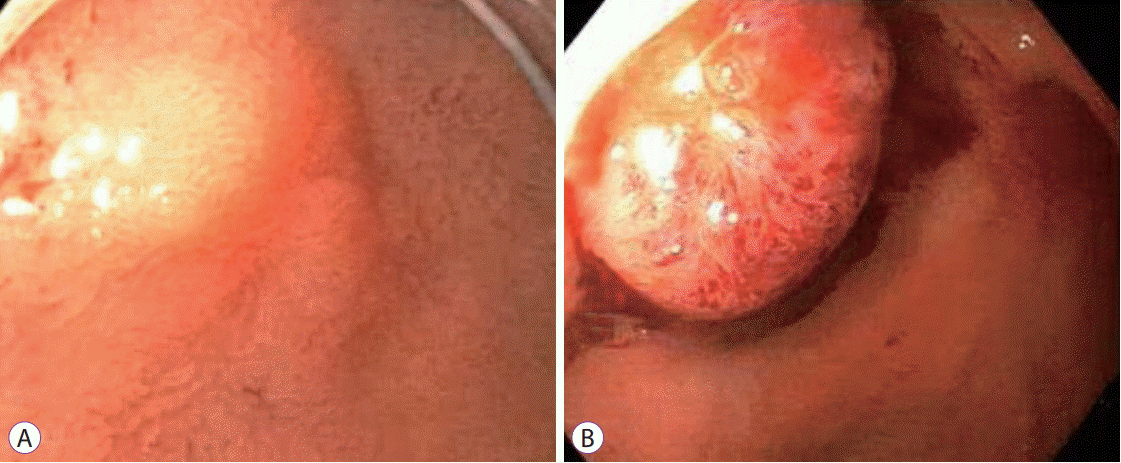 | Fig. 6.(A) Duodenal neuroendocrine tumor. (B) Duodenal neuroendocrine tumor after Padlock clip (Aponos Medical Co., Kingston, NH, USA) application. 
|
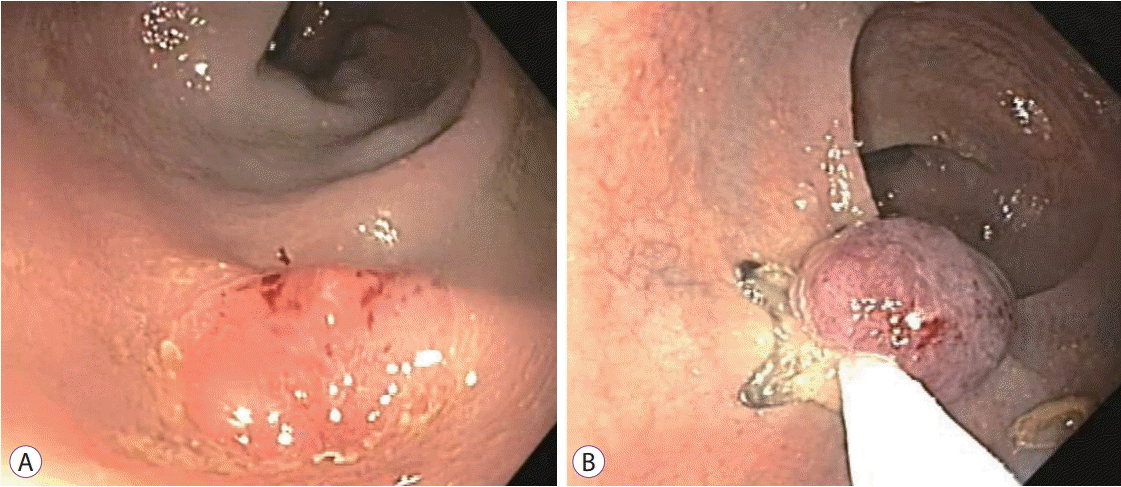 | Fig. 7.(A) Rectal Polyp. (B) Padlock clip (Aponos Medical Co., Kingston, NH, USA) surrounding the polyp. 
|
Go to :

DISCUSSION
The currently available endoclips for controlling GI bleeding are either through-the-scope clips or OTSCs. OTSC (Ovesco) has been safely used for closing GI defects and achieving hemostasis, with excellent results [
1,
2,
5,
6]. The Padlock clip is a novel OTSC that has become popular recently due to its unique full-circumferential closing system. The Padlock clip has also been used recently to successfully seal two GI fistulas after using the Ovesco clip [
4].
Although the working mechanism of the Padlock and Ovesco clip systems are similar, they present some important distinctions. The circumferentially-placed inner prongs of the Padlock clip provide a firm grasp to hold the tissue in place and a thorough closure of the area, which is not observed with the Ovesco clip. The Padlock clip system does not require the operating channel of the endoscope, which is occupied when using the Ovesco clip. Major differences between the Ovesco and Padlock clip have been highlighted in
Fig. 8 and
Table 2.
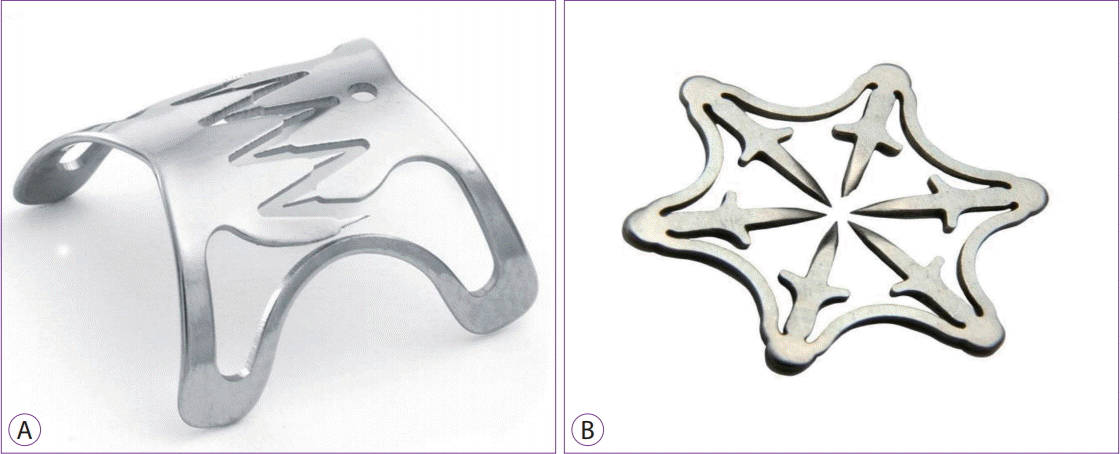 | Fig. 8.(A) Ovesco clip (Tübingen, Germany). (B) Padlock clip (Aponos Medical Co., Kingston, NH, USA). 
|
Table 2.
Comparison between Ovesco and Padlock Clip
|
Ovesco clip |
Padlock clip |
|
Bear claw-shaped |
Hexagonal-shaped |
|
Operating channel of endoscope occupied |
Operating channel of endoscope is free |
|
Invaginates tissue inside cap by suction or by use of twin grasper or anchor |
Invaginates tissue inside cap only by suction and allows for continuous removal of blood and secretions |
|
Absence of circumferential pressure on tissue |
Circumferentially-placed inner prongs create firm hold of tissue and thorough closure |
|
Deployed by string wire connected to a rotating handle |
Deployed using Lock-it delivery system |
|
Remains attached to tissue for a long time (mean, 28 days) [6] |
May remain attached to tissue for a longer period (documented up to 3 mo) [7] |

In the case series published by Dinelli et al., the Padlock clip was used to manage wall defects and GI bleeding in 8 patients, 7 of whom achieved long-term clinical success [
4]. EFTR of colonic lesions was attempted in 6 patients, resulting in full-thickness resection in 50% of the patients and a deep muscle resection in the remaining 50% (with R0 resection in 83.3% of patients).
In another series by Armellini et al. using the Padlock clip, technical success was achieved in all 5 patients: specifically, control of GI bleeding and closure of GI fistula [
7]. Only one adverse event of mild pancreatitis was noted, although its relation to the application of the Padlock clip is questionable.
In the present case series, all patients achieved technical, as well as clinical, success. An absence of adverse events was noted in all patients throughout the procedure and post-procedure period. Hemostasis was achieved in all 4 patients. Patients with gastric ulcer and duodenal ulcer receiving antiplatelet therapy for coronary artery disease had the therapy reinstated shortly after application of the Padlock clip and absence of further GI bleeding was noted. Lamberts et al. has reported rebleeding in up to 35% of patients after application of the OTSC [
8]. However, in a larger multicenter study by Manta et al., the premature manifestation of rebleeding was reported in only 4.4% patients, and there was an absence of rebleeding in the postoperative period [
9]. Rebleeding occurred more frequently in those patients receiving anti-platelet therapy. Inversely, in our previous experience with OTSC, there was an absence of rebleeding after application of the Ovesco clip [
5]. Also, in the present study, there was absence of rebleeding in a follow-up period of a minimum of 3 weeks. Antiplatelet therapy may, therefore, be reinstated shortly after Padlock application due to full thickness closure of the tissue; however, this finding requires further validation in larger studies.
EFTR of the NET and rectal polyp was achieved by Padlock clip application, followed by polypectomy snare removal. Relook endoscopy for all 7 patients revealed the Padlock clip in situ and absence of rebleeding was noted. Padlock clip-assisted EFTR appears to be a safe and effective tool, as well as an alternative to endoscopic mucosal resection, for superficial GI lesions. Nevertheless, complications, such as bleeding, have been reported in 19.2% patients after endoscopic mucosal resection [
10]. Overall, OTSC-assisted procedures are less complicated and have a shorter learning curve. We chose the OTSC-assisted EFTR because, overall, it is a simple and less time-consuming procedure.
In the only randomized control trial comparing Ovesco with Padlock clips, Prosst et al. performed an
ex vivo model experiment that demonstrated that Ovesco consistently halted spurting bleeding; the same could not be said of the Padlock clip [
11]. Nevertheless, all the clinical studies using the Padlock clip for closing GI defects, controlling GI bleeding, and performing EFTR [
3,
4,
7,
12] have demonstrated good results. We have also achieved excellent results in the absence of adverse events in our use of the Padlock clip system. Further randomized clinical trials are needed to compare the efficacy and safety of Padlock versus Ovesco clips.
The limitations of our study are the small sample size and the fact that all procedures were performed by an experienced endoscopist at a specialized center. The disadvantages of the Padlock clip, as well as other OTSCs, include the cost and the need for reintroduction of the endoscope into the cavity in order to apply the Padlock clip.
In conclusion, the Padlock clip is a novel OTSC with benefits that include a safe, simple, and rapid deployment. It may be an effective tool to seal GI wall defects, achieve hemostasis in refractory GI bleeding, and for EFTR of subepithelial and epithelial lesions. If necessary, antiplatelet therapy may be reinstated shortly after the procedure in patients who underwent successful application of the Padlock clip. Further, large multi-center studies are needed to establish the clinical safety of the Padlock clip and to provide comparison with other conventional techniques.
Go to :









 PDF
PDF Citation
Citation Print
Print



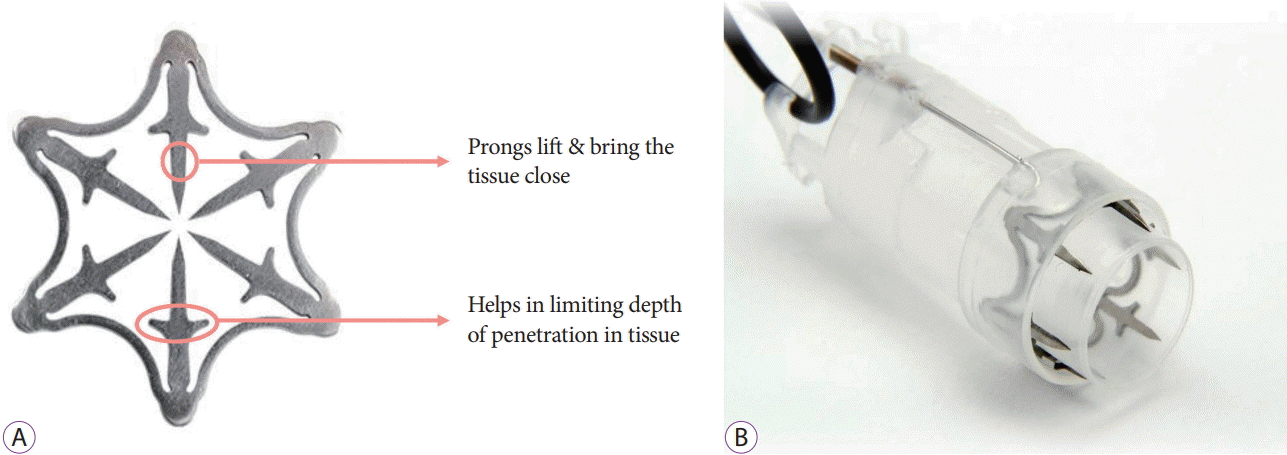



 XML Download
XML Download